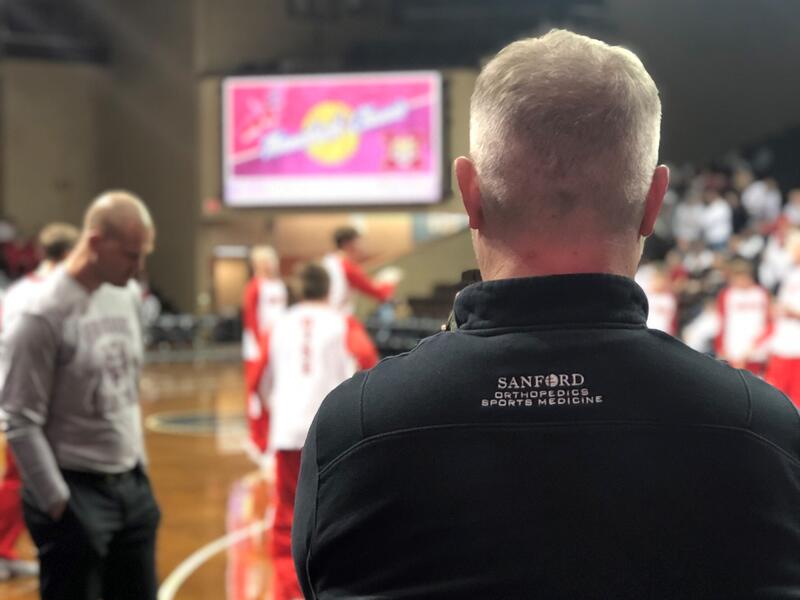The role of athletic trainers at Sanford Health includes a diverse list of duties and responsibilities even when everything is going according to plan.
When it’s not — when a pandemic shows up and hangs around for a year, for instance — the responsibility list gets longer and wider. At no time has that been more apparent than the last 12 months. In partnership with athletes, coaches, parents and schools, athletic trainers have been asked to weave through a complex set of circumstances brought on by the presence of COVID-19.
The anniversary of the pandemic arrived in March. Those conditions, unfortunately, have not disappeared just yet.
These new conditions brought to light how useful and valuable athletic trainers really are. As the conditions have evolved over the last year, so too has their role in helping guide the world of sports through the pandemic’s challenges.
It all starts at Sanford with a strong foundation. Tryg Odney is Sanford Health director of sports medicine outreach with a specialization in orthopedics and athletic training. He explains the role of a Sanford athletic trainer like this:
“Athletic trainers in school settings provide an educated resource for coaches, athletes, parents and administration to know that the medical needs of athletes are being addressed.”
It doesn’t mean athletic trainers handle everything. It does mean they will evaluate, treat and provide referrals when appropriate.
“We provide the communication conduit between groups,” Odney said. “We do this to ensure that the foundation of everything we do is about athletes’ safety. It’s involved in every decision we make.”
Athletic trainers on the front line
It makes athletic trainers front-line workers, to use a term we’ve all become familiar with during the pandemic. In this case, it’s a role that has become an indispensable part of sports and competition. In the Midwest, is backed by a network of Sanford Health providers that extends well beyond the sidelines.
“Our Sanford athletic trainers provide injury care, they rehab kids, they get them back to competition,” said Todd Olson, director of student activities for Fargo public schools. “The athletic trainers are responsible for everything from emergency planning to working to get our schools designated as NATA (National Athletic Training Association) Safe Sport Schools. When I look at the full gamut of what our athletic trainers contribute to our athletic departments, I’m very thankful.”
Olson has seen up close how the pandemic broke up the rhythm for high school athletes. In South Dakota and North Dakota the impact has been less dramatic than it has been in some other states, but it’s not like things are completely back to normal.
“One of the most difficult things has been the lack of ability to socialize away from school activities,” Olson said. “Not being able to go to school full-time all year has been hard on a lot of kids, but in terms of sports, we’ve probably had as close to normal sports seasons as we could ever hope to have.”
Essential to health care
The onset of COVID-19 began with a shutdown for sports. Nobody was really able to do much of anything but sit, wait and wear a mask. When pressure on Sanford caregivers was most intense, they were able to tap athletic trainers for other roles such as COVID-19 screeners.
“We worked with leadership to identify where there were needs,” Odney said. “We have this educated staff that can do a lot of things. Our athletic trainers are good multitaskers and good communicators. We found spots within the organization where they were valuable in a lot of different roles.”
It also served as a vehicle to demonstrate commitment. So I have to take a break from my real job because of the pandemic? Well, how else can I help out?
Thankfully, doors began opening again for sports in June in North and South Dakota. The interaction between athletic trainers and athletes and coaches resumed, albeit with new guidelines.
“Our athletic trainers spent a lot more time at the schools last summer than they usually do,” Odney said. “We were totally fine with that because it got everyone back to the settings where they normally operated. It meant there was a need for medical knowledge on site. We were able to make sure that we were accomplishing the goals that we had for the protocols to mitigate COVID.”
The NATA Month slogan for this year is “Essential to health care” and the past 12 months definitely demonstrate that it’s not just a series of words. In this case, it’s who they are and what they do.
“Athletic trainers are often out in the schools and people might not think of them as being connected to our medical centers,” Odney said. “I think the last year we’ve connected those dots for a lot of people. We had a dozen of our people trained in collecting COVID samples, for instance. The slogan ‘Essential to health care’ hits the mark for me. It reminds us our athletic trainers have a lot of value that goes beyond the sports teams at our schools.”
Learn more
- Students, former patients benefit from doctor’s legacy
- Athletic trainers, coaches help screen clinic visitors
- High school wrestler returns to the mat after concussion
…
Posted In Allied Health, Orthopedics, People & Culture, Sports Medicine
